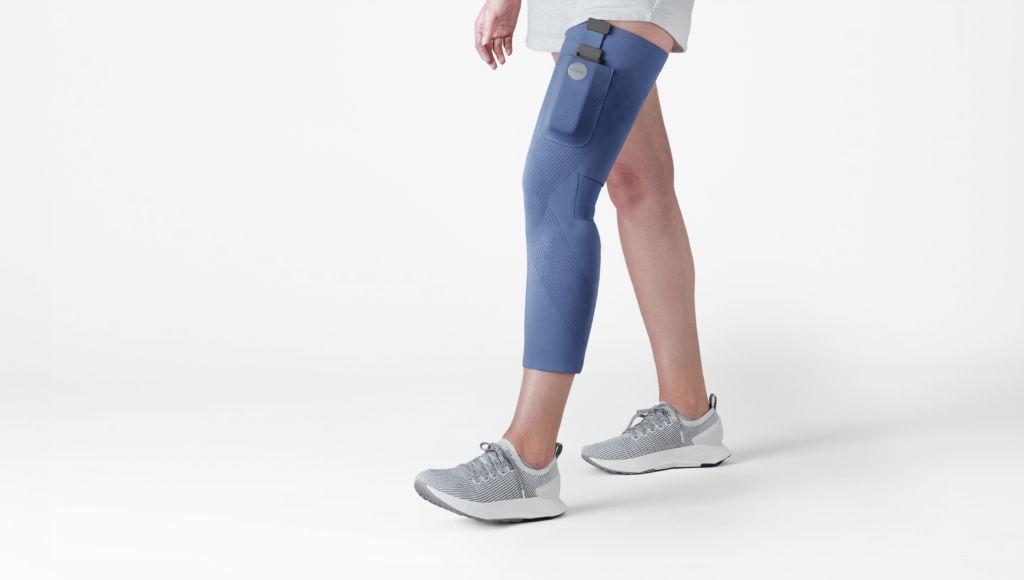
Pre-gait and strengthening exercises are essential components of rehabilitation for individuals with mobility differences. At CIONIC, we’re on a mission to help you improve strength, balance, range of motion, and overall walking ability. We are excited to announce the latest updates to our app, which have been developed based on your valuable feedback to introduce more complex movement patterns into the exercise protocols.
The initial set of exercises is ideal for individual movements targeting each of the four muscle groups the Neural Sleeve augments. Toe Raises assist with dorsiflexion in the shin, Calf Raises target the plantar flexors, Knee Extension targets the quadriceps, and Knee Flexion targets the hamstrings.
However, we heard some common challenges we wanted to address beyond these first four exercises. Those challenges were:
- Ankle Inversion: some individuals with ankle instability may benefit from strengthening the evertors to prevent inversion
- Extensor patterns within the swing phase of gait: some people experience difficulty raising their foot while activating the quadriceps to extend the knee
- Transitioning between plantarflexion and dorsiflexion during gait: this protocol is intended to help individuals who experience difficulty performing this movement pattern
- Standing knee flexion exercise: some individuals wanted to perform the exercise in a seated position, rather than while standing
New exercises included in our latest software release — 1.14 — include Swing, Rockers, Eversion, and Seated Hamstring. If you haven’t already, visit the Apple App Store or Google Play Store to confirm you have the latest software for your Neural Sleeve. Once you have the latest app, upgrade the firmware as well.
If you are unfamiliar with any clinical terms referenced in this article, you can read our glossary of terms found at the bottom of this article. Otherwise, here’s a guide to our new exercises.
Swing
Swing is a new exercise that involves performing active dorsiflexion with knee extension. This exercise offers a more complex movement pattern than single movement patterns (such as just practicing dorsiflexion with the toe raises). If you have difficulty lifting your toes when contracting your quadriceps, this exercise may be a good option for you.
Why Is Swing Important?
During gait, active knee extension with dorsiflexion is needed to achieve adequate heel strike at initial contact and allow the body to progress smoothly over the fixed foot.
However, some individuals experience increased muscle tone or spasticity which may lead to an extensor synergy pattern in the leg. This extensor synergy often results in knee extension and plantarflexion making it difficult to dorsiflex the ankle during the swing phase of gait resulting in decreased toe clearance and heel strike. Practicing Swing can help break the extensor synergy pattern to allow for knee extension with dorsiflexion.
Studies show that active dorsiflexion with knee extension also leads to more strength gains than if the ankle is neutral or plantarflexed.
Setting up Stimulation for Swing
You will set up two muscle groups for this exercise — the shin, and the quadriceps.
- Shin: use settings similar to your preferred gait protocol, or during Toe Raises to get adequate dorsiflexion
- Quadriceps: for this panel, use similar settings to the Knee Extension exercise protocol
Swing: Key Differences in Timer Activated/Muscle Activated vs. Biofeedback Exercise Protocol
Unlike previous exercises where the Timer Activated, Muscle Activated, and Biofeedback versions of the exercise protocol stimulate (or measure, in the case of biofeedback) the same muscles but using different mechanisms, there is a slight variation with Swing.
- Muscle Activated Swing — in this protocol, you have the option to only stimulate the shin during the motion or to stimulate both shin and quadriceps. The quadriceps can be turned off by setting intensity to zero if desired or set to a comfortable level of stimulation. The active contraction of the quadriceps to extend the knee is what triggers the stimulation for the quadriceps and shin during this exercise
- Timer Activated Swing performs as you would expect — when it’s time to engage your muscles, both the shin and quadriceps electrodes will provide stimulation in accordance with the timer and your settings, and stop during the “relax” phase
How To Perform Swing
As always, we recommend watching the tutorial video accompanying the content to view a live recording and description of the motion of this exercise.
- Start in a seated position with both of your feet flat on the ground. Your knee should be directly aligned above your ankle (if possible, or slightly away from your body).
- Keeping your thigh in contact with the chair, straighten your leg by lifting your toes to create a straight line from your hip to your foot.
- As you straighten your leg, continue to actively lift your toes to dorsiflex the ankle.
Rockers
Rockers are a rhythmic, back-and-forth exercise designed to improve dorsiflexion and plantarflexion. Rockers also help improve ankle joint range of motion, flexibility of the calf muscle, and overall ankle stability.
What Does Practicing Rockers Help With?
Practicing Rockers helps address difficulties with dorsiflexion during the swing phase of gait. As the person pushes off the ball of the foot in a plantarflexed position, there is a transition from plantarflexion to dorsiflexion to clear the toes (“forefoot rocker”) as the body moves forward over the opposite, or contralateral, leg.
In order to achieve proper dorsiflexion, the plantarflexors must relax in order for the dorsiflexors to contract. When an individual exhibits an extensor synergy it is sometimes challenging to relax the plantarflexors. This exercise can help train a smoother transition from plantarflexion to dorsiflexion as well as strengthen the dorsiflexors needed for toe clearance.
Setting up Stimulation for Rockers
You will set up two muscle groups for this exercise: the shin and the calf.
- Shin: use settings similar to your preferred gait protocol, or during Toe Raises to get adequate dorsiflexion.
- Calf: for this panel, use similar settings to the Calf Raises exercise protocol. Enough stimulation to get a muscle contraction, if desired
Rockers: Key Differences in Timer Activated vs. Muscle Activated Exercise Protocol
Similar to Swing, the Timer Activated and Muscle Activated versions of the Rockers exercise protocol have key differences:
- Muscle Activated Rockers — this protocol uses a new type of EMG triggering based on the “relax” muscle readings (previous exercise protocols have used muscle-activated stimulation to augment the activity during active contraction). It uses the relaxation of the calf muscle (gastrocnemius) to trigger the contraction of the shin muscle (tibialis anterior) to aid with dorsiflexion
- Timer Activated Rockers performs as you would expect — when it’s time to engage your muscles, both the shin and calf electrodes will activate in accordance with the timer and your settings, and stop during the “relax” phase
How To Perform Rockers
- To perform this exercise, sit upright with both your feet flat on the ground. Your knee should be directly aligned above your ankle (if possible, or slightly away from your body).
- Lift your toes while keeping your heels on the ground.
- Return your toes to the ground.
- Lift your heels while keeping your toes on the ground.
- Return your heels to the floor.
Eversion
Eversion refers to the movement of the foot and ankle that involves turning the sole of the foot outward, away from the midline of the body. It is the opposite movement of inversion in which the sole of the foot turns inward with the outside edge of the foot moving downward.
What Does Practicing Eversion Help With?
Practicing eversion can help restore optimal gait mechanics and improve ankle stability. If you struggle with excessive inversion (or inward rolling) while walking, it can lead to decreased balance, ankle sprains, and a higher risk of falls.
Practicing eversion strengthens the peroneal muscles (peroneus longus, peroneus tertius, peroneus brevis), which are the dynamic stabilizers for the lateral ankle. In short, eversion strengthening exercises can help create increased ankle stability and reduce your risk of falls.
Setting up Stimulation for Eversion
To set up stimulation for dorsiflexion, which is common for the gait protocol and Toe Raises exercise, the medial electrodes are often selected to target the Tibialis Anterior muscle.
If you wear a LEFT Neural Sleeve, these comprise the second of the two columns of electrodes on the setup screen.
With eversion, you want to do the opposite, or activate the LATERAL electrode column to target the peroneal muscles. Select the electrodes in the first of the two columns. Adjust the intensity until you get a comfortable contraction.

If you wear a RIGHT Neural Sleeve, your medial electrode column, or the electrodes often selected to target the Tibialis Anterior muscle, are in the left-hand column, or the first column in this diagram. This is what your settings may look like when you set up dorsiflexion in your gait protocol.
To set up eversion on the right side, deselect the left hand, or medial, electrode column, and instead, select the electrodes in the right-hand column. Adjust settings until you get a comfortable contraction.

How To Perform Eversion
- Sit upright with both of your feet flat on the ground. Your knee should be directly aligned above your ankle (if possible, or extended slightly away from your body).
- Lift your foot up and out to the side.
- Return your foot to the floor.
Seated Hamstring
The Seated Hamstring exercise protocol is a seated alternative to the Knee Flexion exercise protocol. We heard from many customers that they preferred to perform exercises while seated.
Setting up Stimulation for Seated Hamstring
To perform this exercise, set up your hamstrings parameters the way you would during standing Knee Flexion, or until you get a comfortable contraction.
How To Perform Seated Hamstring
- Sit upright with both of your feet flat on the ground. We recommend wearing only socks for this exercise.
- Extend your foot out in front of you as much as possible with your heel on the ground.
- Slide your foot back towards the chair as much as you can while keeping your heel on the ground.
- Return your foot to the starting position.
New Metrics
In addition to introducing new exercises, we’ve heard from many of you how important it is to track your progress. We’re happy to share that we’ve made some significant improvements to the activity tracker found in the History screen. Now, in addition to tracking session history, you can see:
- Daily activity summary: this includes all activities performed while wearing the Neural Sleeve
- Gait speed: sometimes referred to as the “sixth vital sign,” walking speed “is a valid, reliable, sensitive measure appropriate for assessing and monitoring functional status and overall health in a wide range of populations” [cit]
- Stride length: in addition to walking speed, increased stride length is connected to overall mobility improvements [cit]
- Plus trend lines to monitor weekly changes to these metrics over time
You can also view these metrics while you’re in your Gait Protocol by touching the right and left arrows during the session.
In Conclusion
The system gets smarter every time we release software and new features will always be driven by you. Your feedback and suggestions have been crucial in the development of our latest updates, and we want to thank you for your continued support.
As always, if you have any feedback, suggestions, or questions, please do not hesitate to reach out to our support team by emailing support@cionic.com. Here’s to more mobility milestones!
Glossary of Terms
Muscle Contraction:
Muscle contraction refers to the activation of muscle fibers. When a muscle contracts, it generates tension, resulting in movement or the ability to resist forces. There are different types of muscle contractions, including concentric (muscle shortens), eccentric (muscle lengthens), and isometric (muscle remains the same length). Muscle contractions are responsible for various voluntary and involuntary movements in the body.
EMG:
EMG stands for electromyography, which is a technique used to assess and record the electrical activity produced by muscles. It involves the placement of small electrodes on the skin overlying specific muscles or directly inserting needle electrodes into the muscle tissue. EMG provides valuable information about muscle activation patterns, muscle recruitment, and the timing and intensity of muscle contractions. It is commonly used in research, clinical assessments, and rehabilitation to evaluate muscle function and diagnose neuromuscular disorders.
Knee Extension:
Knee extension refers to straightening or extending the knee joint, moving the lower leg away from the thigh and increasing the angle between the two. It is the opposite movement of knee flexion. Knee extension is essential for activities such as walking, running, and standing upright.
Dorsiflexion:
Dorsiflexion is the movement of the ankle joint that brings the top of the foot closer to the shin. It involves lifting the toes and flexing the foot upward. Dorsiflexion is necessary for activities such as walking, running, and maintaining balance. It is the opposite movement of plantarflexion.
Plantarflexion:
Plantarflexion is the movement of the ankle joint that points the toes downward or away from the shin. It involves extending the foot and ankle, pushing the foot away from the body. Plantarflexion is essential for actions such as walking, running, jumping, and standing on tiptoes.
Inversion:
Inversion is the movement of the foot that involves turning the sole inward, towards the midline of the body. It occurs at the subtalar joint and involves a combination of ankle adduction and supination. It is the opposite movement of eversion.
Eversion:
Eversion is the movement of the foot that involves turning the sole outward, away from the midline of the body. It occurs at the subtalar joint and involves a combination of ankle abduction and pronation. It is the opposite movement of inversion.
Subtalar Joint:
The subtalar joint is the articulation between two of the bones in the foot — the calcaneus (heel) and the talus (the bone directly above the calcaneus). This joint allows for the movements of inversion and eversion.
Tibialis Anterior (TA): The tibialis anterior muscle is the most medial muscle of the anterior compartment of the leg. It is responsible for dorsiflexing and inverting the foot, and is the largest dorsiflexor of the foot.
Peroneal Muscles:
The peroneal (or fibularis) muscles of the lower leg consist of peroneus (fibularis) longus, peroneus (fibularis) brevis, and peroneus (fibularis) tertius. These muscles are responsible for ankle eversion. The peroneus longus and peroneus brevis can also contribute to plantarflexion. The peroneus tertius, although not present in all individuals, can contribute to dorsiflexion. These muscles provide dynamic lateral ankle stability.
Medial: Medial refers to a position or direction toward the midline of the body or a body part. It is the opposite of lateral. When referring to the human body, the midline is an imaginary line that divides the body into equal left and right halves. Therefore, structures or movements that are closer to the midline or directed toward it are described as medial. For example, the medial side of the knee refers to the side closer to the midline of the body.
Lateral: Lateral refers to a position or direction away from the midline of the body or a body part. It is the opposite of medial. When referring to the human body, structures or movements that are farther away from the midline or directed away from it are described as lateral. For example, the lateral side of the knee refers to the side farther away from the midline of the body.
Extensor Synergy:
Extensor synergy refers to a pattern of movement involving the coordinated activation of extensor muscles in the body. It often occurs in response to stimuli or during specific tasks and is characterized by the simultaneous activation of multiple extensor muscles to produce a desired movement or maintain stability. Extensor synergies play a significant role in maintaining posture, balance, and performing functional activities. In the leg the extensor synergy includes extension of the hip and knee, plantarflexion, and inversion of the ankle.
Swing Phase:
The swing phase is a specific part of the gait cycle during walking or running. It refers to the period when the leg is lifted and advanced forward in preparation for the next step. The swing phase involves the coordinated movement of the hip, knee, and ankle joints to clear the foot from the ground and propel it forward. It is followed by the subsequent stance phase when the foot makes contact with the ground.
Loading Response:
Loading response refers to the initial phase of the gait cycle when the foot makes initial contact with the ground. It involves weight-bearing on the stance limb, absorption of impact forces, and stabilization of the body. The loading response sets the foundation for the subsequent phases of the gait cycle.





